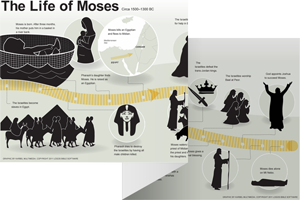3:1–22 After defeating Sihon, the king of the Amorites at Heshbon (Deut 2:26–37), the Israelites continued north to the Amorite kingdom of Og, ruler of Bashan. |
3:1 to Bashan Both the ot (see Deut 3:11–13) and tablets from an ancient city-state called Ugarit (located in present-day Syria) associate this region with the Rephaim. The ot describes the Rephaim as mighty warriors of unusual height (see 2:10–11; 3:11–13), and the Ugaritic
(located in present-day Syria) associate this region with the Rephaim. The ot describes the Rephaim as mighty warriors of unusual height (see 2:10–11; 3:11–13), and the Ugaritic texts describe them as ancient warriors and denizens of the underworld; for this reason, Bashan was considered the gateway to the underworld.
texts describe them as ancient warriors and denizens of the underworld; for this reason, Bashan was considered the gateway to the underworld.
Og the king of Bashan Og is described as the last of the Rephaim (or Rephaite) giants (see vv. 11–13; Josh 12:4), though the greater region of Bashan is still referred to as the land of the Rephaim (or Rephaites; Deut 3:13).
is described as the last of the Rephaim (or Rephaite) giants (see vv. 11–13; Josh 12:4), though the greater region of Bashan is still referred to as the land of the Rephaim (or Rephaites; Deut 3:13).
 Giant Clans in the Old Testament
Giant Clans in the Old Testament
at Edrei One of the main cities of Bashan. See Num 21:33; Deut 1:4.
3:2 Sihon the king of the Amorites See Num 21:21–30; Deut 2:26–37; and note on 2:24.
3:6 we destroyed utterly See note on 2:34.
males, the women, and the little children The Israelites did the same to the Amorites of Sihon of Heshbon (see Num 21:2; Deut 20:16–17; compare 9:15). The Amorite populations were killed according to cherem, the Hebrew word designating people or property dedicated to sacred use. See note on Josh 6:17; Deut 2:34 and note.
3:8 the control of the two kings of the Amorites A reference to Sihon and Og.
on the other side of the Jordan A reference to the Transjordan.
Mount Hermon The southernmost peak of the Antilebanon mountain range. This mountain is commonly referenced to indicate the northern border of the region of Bashan (see Josh 12:1, 5).
Mount Hermon |
3:9 The Sidonians called Hermon ‘Sirion,’ and the Amorites called it ‘Senir Sidon was a Phoenician city. Both “Sirion” and “Senir” occur outside the ot in Ugaritic, Hurrian, Hittite, and Akkadian texts.
3:10 Gilead The area north and south of the Jabbok River. See Deut 2:37; compare Gen 32:22; Num 21:24; Josh 12:2; Judg 11:22.
3:11 the remnant of the Rephaim See note on Deut 2:11. See Num 13:33; Deut 2:10–11; Josh 12:4; 13:12; compare Gen 6:4.
 Giant Clans in the Old Testament
Giant Clans in the Old Testament
his bedstead—it was a bedstead of iron Og’s bed, which functioned like a museum piece, was still in Rabbah. Iron was unusual for the time period (Late Bronze Age); this, along with the bed’s unusual size, would have accounted for its notoriety.
Rabbah of Present-day Amman, Jordan.
Nine cubits is its length, and four cubits is its width The iron bed was 13 feet long and six feet wide, presuming a standard cubit of approximately 18 inches. This point is meant to emphasize Og’s incredible height—he was a giant. Compare note on Deut 2:11.
3:15 And also I gave Gilead to Makir The family of Machir were descendants of Manasseh. See Num 32:39–40.
3:18 shall cross over Though they have conquered and received their portion of the inheritance, the fighting men of the Reubenites, Gadites, and the half tribe of Manasseh were expected to assist the remainder of their countrymen in their own struggle as they enter the land. See Num 32:20–21; Josh 1:14; 4:12.
3:20 your brothers Fulfillment of God’s promise to these tribes finds its fulfillment in Josh 22:4.
3:22 Yahweh your God is the one fighting for you See Exod 14:14 for similar language.
3:23–29 Moses closes his historical recap with the account of how he was unable to lead the people into the promised land. Instead, Joshua will lead Israel during the conquest of Canaan. Moses was only allowed to look out and see the land from a distance (Num 27:12–23). He was forbidden from entering the land because he had disobeyed Yahweh at Meribah (Num 20:2–13). |
3:24 for what god is there in the heaven or on the earth who can do according to your works and according to your mighty deeds? See Exod 15:11 and note.
3:25 the good land that is beyond the Jordan Moses recounts his intercession with God to change His mind regarding the punishment in Num 20:1–13. Moses hoped God would let him enter the land of Canaan.
3:26 because of you Here and in Deut 1:37 Moses frames the incident at Meribah in a way that blames the Israelites for Yahweh’s decision to punish him (Num 20:2–12), but Yahweh will allow no excuse for disobedience of His command. Moses is punished for his own actions, aside from the root cause.
3:27 Go up to the top of Pisgah Although God did not let Moses set foot in the land (see Num 20:1–14), He does allow Moses to see it from this vantage point.
3:28 instruct Joshua Moses appoints Joshua as his successor. See Num 27:19.

|
About Faithlife Study BibleFaithlife Study Bible (FSB) is your guide to the ancient world of the Old and New Testaments, with study notes and articles that draw from a wide range of academic research. FSB helps you learn how to think about interpretation methods and issues so that you can gain a deeper understanding of the text. |
| Copyright |
Copyright 2012 Logos Bible Software. |
| Support Info | fsb |
 Loading…
Loading…


 Mount Hermon
Mount Hermon 